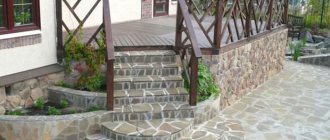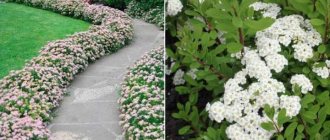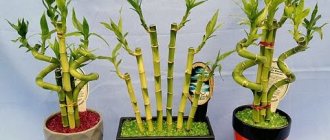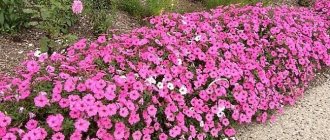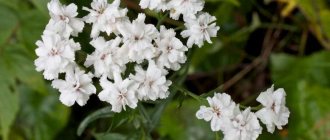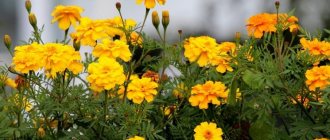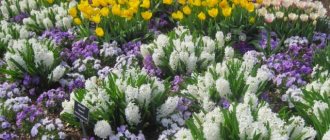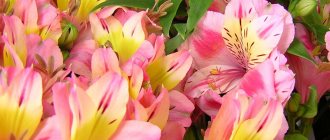Home/Flowers and plants/Flower bed for “lazy people”. Frost-resistant unpretentious perennials. What to plant?
Agree, it often happens that you get excited about an idea, bring it to life, and then the interest fades away. I wanted to have a beautiful flowerbed - it was done. And then, there is no time to take care or you are simply lazy, and the beautiful flower garden becomes overgrown with weeds, or, on the contrary, it grows so much that it ceases to be decorative.
There is an exit. The main thing is to wisely choose plants that do not require constant attention and care.
Brunner
Herbaceous perennial. Due to its characteristics, Brunnera is often used in composition to create borders. The flowers look like forget-me-nots. Undemanding in care, but does not tolerate heat well. Winter-hardy. It can grow in one place for a long time without transplantation (up to 15 years). Despite its unpretentiousness, it is better to choose shady places for planting.
Perennial cornflower
Survival champion. A huge number of varieties. Completely undemanding to soil composition. Very popular among gardeners. It blooms and pleases the eye for a long time and beautifully. Watering is moderate, not needed in winter. Used as a background in compositions. It is a good honey plant.

Garden geranium
There are tall and short. Winter-resistant, drought-resistant. Not only flowers, but also leaves are decorative. There are about 40 species. It blooms for a month and a half. Very decorative. Can be used in group compositions and to fill individual voids. The leaves and roots of garden geranium have medicinal properties.
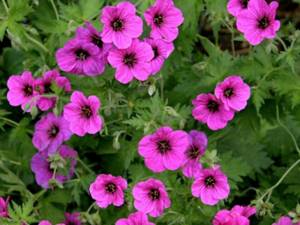
Loosestrife
A very hardy, unpretentious, and, at the same time, very ornamental plant. Prefers moist soils. Ideally planted on the shore of a pond. Blooms throughout the summer season and September. If planted in dry places, it needs periodic watering. In their absence, it will not die, but will lose its decorative effect. In design, it looks good in any combination.
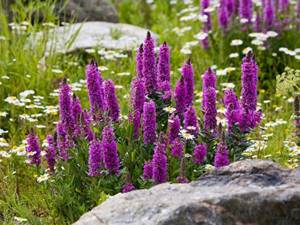
Doronicum
Doronicum flowers are similar to chamomile, only with yellow leaves. It begins to bloom in spring and continues until July. Prefers well-lit places. Looks good in a flower garden, especially in a campaign of ferns.
Can be planted as a central spot in compositions. Needs watering periodically. Some varieties look beautiful in rock gardens, near free-standing stones.
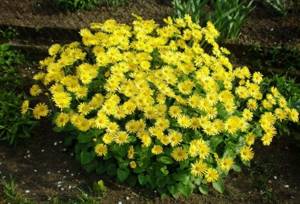
Kupena
The plant is somewhat similar to lilies of the valley. It is quite unpretentious, but it is better to plant it in the shade, where it looks very beautiful. It grows in the same place for a long time - up to 15 years. Has medicinal properties.
Retains its elegance all season long and fits well into any landscape. Can be used to decorate the lower bare parts of tall plants. It is not demanding on the soil and does not require watering. Tolerates winters well.

Lupine
It differs in that it blooms twice a year - in summer and autumn, at the beginning. In a flowerbed, it looks more impressive in a group of several flowers. Prefers slightly acidic soils. Due to its height, it is best planted in central or distant compositions. The plant is susceptible to aphid attack.
It is necessary to periodically treat flowers and soil with insecticides. It can live in one place for 3 - 4 years. Sometimes it requires the help of supports so as not to break under its own weight.
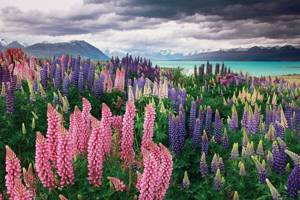
Caring for all the plants described above does not require much time and this is why they are valuable. All descriptions are given for standard conditions. Naturally, if there is prolonged heat and drought in the summer, any plant will need watering.
When growing for a long time in the same place, fertilize with fertilizers and microelements. But in general, all of them will delight their owners with a minimum of labor costs.
AllaAuthor of the article
Did you like the article?
Share with your friends:
Comments (3)
- Valentina December 27, 2021 at 11:53 pm
Plant Lupine or Kupena, then you will go crazy, they will grow so much that you will think about how to get rid of them.
Answer
- Evgenia January 02, 2021 at 06:13 pm
Not always Valentine. I dream that Lupines will grow)) and the plants will die.
Answer
- Irina December 24, 2021 at 11:31
If watering is required periodically, then this is no longer for lazy people. If only there were ones that don’t really need watering, and that don’t have any requirements for the soil, such as marigolds. Is there anything like that? At our dacha everything burns down in May while we are not there. We live in the south.
Answer
Description of the main types of ground covers
Below are names and descriptions of groundcover perennials, grouped in alphabetical order for ease of reference.
Canadian anemone
An elegant ground cover flowering plant is the Canadian anemone (Anemone canadiensis) during the flowering period the shoots reach 30 cm. The anemone blooms in the spring with large white flowers. Decorative leaves have a characteristic star-shaped shape.
Anemones should be planted in a sunny or semi-shady location. Blooms less profusely in the shade. Looks good in all types of gardens and complements other plants. An easy to grow perennial that grows in any garden soil that is moderately moist. Can cope with periods of drought. Recommended for flower beds, rock gardens, planting under trees and shrubs. Creates a charming green carpet.
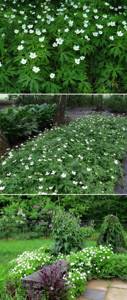
Armeria seaside
Evergreen perennial groundcover flowers - Armeria maritima, up to 20 cm high, blooms from May to September. Pink flowers are collected in inflorescences on hard stems. An unpretentious plant, it grows on poor, permeable soil (sandy coast) and clay soils with a lot of sand. Does not like drought or heat; excess water can lead to rotting. Frost-resistant plant, but it is better to cover it for the winter. Ideal for rock gardens.

Bergenia cordifolia
A beautiful evergreen plant with thick creeping rhizomes for shade and sun is Bergenia cordifolia. In nature it grows in damp places on rocky terrain and rocks. Bergenia is tolerant of its habitat; average garden soil is suitable.
Large round leaves are collected in magnificent rosettes, dark green, leathery, smooth and shiny, on thick petioles. In autumn the leaves turn slightly red. Bergenia blooms in spring (April–May), producing thick, reddish inflorescences with numerous bell-shaped flowers. Depending on the variety, the flowers are pink, red, purple, cream, and white.
These are long-lived, hardy, easy-to-grow plants. They like medium, moderately moist soils and cope well with drought. Planted in full sun, they bloom more profusely, but require higher soil moisture. Frost-resistant. Ideal for planting in flower beds and covering large park areas. Bergenia can be planted in rock gardens, on the banks of reservoirs, which it strengthens and protects from erosion.
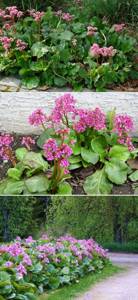
Periwinkle
A creeping, evergreen shrub with shiny leaves, periwinkle (Vinca), comes in many varieties. Grows slowly, up to 30 cm in height and 0.5 m in width. The leaves are elliptical, dark green, shiny, leathery. Blue flowers have 5 petals.
Periwinkle prefers fertile, humus soils. Planted in parks, gardens, under the canopy of trees. Periwinkle can be planted from March to November.

Euonymus Fortune
The evergreen creeping plant Fortune's euonymus (Euonymus fortunei) grows in Korea and China. In natural conditions, euonymus is usually found as a bush or vine with leathery, shiny leaves. Varieties are characterized by significant variability. Plants prefer semi-shaded places, but also grow in sunny areas. In well-lit positions, the leaves will sparkle beautifully. The soil should be humus and fertile, although euonymus also grows on poor soils.
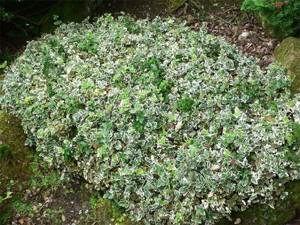
This is a frost-resistant plant that is resistant to urban pollution. Tolerates temporary droughts. Euonymus is an excellent ground cover, suitable for large lawns, strengthening slopes, and climbing up fences.
The best varieties for ground cover mission:
- Fortunea Coloratus.
- Gaiety fortune - with small leaves with a white edge, shoots spread along the ground, creating carpets of green and white.
- Emerald Gold - has small green leaves with bright yellow edges.
- Fortunea Sunspot has green tiny leaves with a bright yellow center.
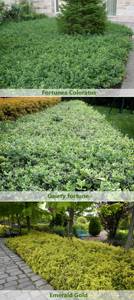
Brunnera macrofolia
Forget-me-not or Caucasian forget-me-not or brunnera macrophylla (Brunnera macrophylla) is a perennial with a shoot height of up to 40 cm, a bush width of up to 60 cm. Large, decorative heart-shaped leaves up to 25 cm long are green, gray and white, often two-colored, pubescent below. The flowers are small, reminiscent of forget-me-nots, blue or white. Flowering period: April – June.
Brunnera grows best in partially shaded positions. Prefers fertile, humus-rich, moderately moist soils with a slightly alkaline reaction. Tolerates weak soils. Completely frost-resistant. Watering required.
Brunnera is a good decoration for shady flower beds, the banks of ponds, and can grow under the canopy of trees (as long as the soil is moist).
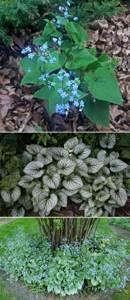
Budra ivy-shaped
Perennial ivy budra (Glechoma hederacea) - reaches 15 cm, has the shape of a carpet. Grows quickly. The leaves are dark green, heart-shaped, with a white serrated edge. It blooms from April to June, the flowers are small, blue-violet, and have a pleasant spicy smell. The most commonly grown variety is 'Variegata', which has variegated leaves and rarely blooms.
The plant requires fertile, moist, mineral-rich soil in a semi-shady position. If the budra grows too much, it can be dug up. The soil should not dry out, otherwise the water will quickly turn brown. Frost-resistant perennial, readily visited by bees. Beautifully covers walls and meshes. Perfect as a green or colorful addition to compositions on the balcony.

Waldsteinia trifoliata
An interesting perennial, Waldsteinia ternata - height varies between 10-20 cm and can quickly cover fairly large areas. The leaves are small, slightly shiny, green, similar to strawberry leaves, and remain on the plant in winter. In spring (April - May), Waldsteinia is additionally decorated with bright yellow five-petaled flowers, collected in inflorescences growing on thin, green stems. If the flowers are pollinated, after blooming they develop into small red seed heads, much like strawberries, but inedible.
Waldsteinia does not have high environmental requirements and is quite easy to grow. The most important thing is proper soil moisture; the plant does not like drying out or flooding. It grows and blooms best in semi-shaded places, on moderately fertile, relatively moist soils. In sunny places with sufficient humidity it produces more flowers; in semi-shaded areas and fertile soils it grows abundantly, creating lush green carpets.
Not susceptible to disease, ideal for planting on slopes, empty areas, along walls.

Coin loosestrife
Lysimachia nummularia produces long shoots with small green or yellow leaves. It is found in lowlands, on the banks of streams, and in damp forests. Creates extensive low-growing (5 cm) carpets. The stems are densely covered with foliage along their entire length. Blooms from June to August (sometimes until September). Lemon-yellow or intense yellow flowers up to 3 cm in diameter, grow separately or in pairs in the leaf axils.
Loosestrife likes moist clay soil, moderately fertile, neutral. It is frost-resistant, but it is better to cover the shoots for the winter. Tolerates dry soil well. It grows and blooms better in the shade, along the banks of reservoirs. Spreads throughout the area, suppressing other plants.
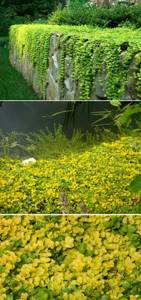
Dianthus pinnata
Ground cover plumose carnation (Dianthus plumarius) is found in lowland areas. Creates a dense low lawn (length of shoots – 30 cm). Cloves can be recognized by their lanceolate, pointed, narrow leaves, 2-5 cm long and several millimeters wide. The entire plant is blue-green. The stem branches and fragrant flowers grow at the tops.
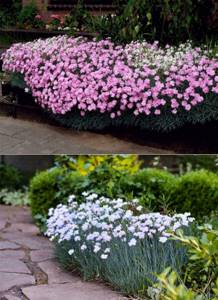
Geranium macrorhizomatous (crane beetle)
About 15 species of the genus Geranium grow naturally in our country. Garden varieties of geranium are valued for their decorative foliage and abundant flowering. Geraniums grow quickly.
Large-rhizome geranium (G. macrorrhizum) is used as a ground cover and lawn plant. This is a low plant (30-40 cm). The leaves and stems are densely covered with hairs. In autumn the leaves turn slightly red. It blooms from May to July, producing pink-red flowers consisting of five rounded petals.
Photo. Large rhizomatous geranium
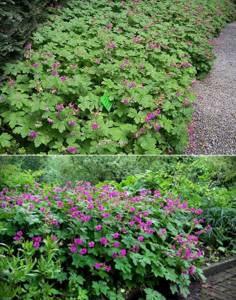
Geranium cambridge
Cambridge geranium (Geranium cantabrigiense), obtained by crossing Dalmatian geranium (G. dalmaticum) with large-rhizome geranium (G. macrorhizum), is also used as a ground cover and lawn plant. Grows up to 30 cm. The leaves are matte and fragrant. Decorative pink flowers develop from June to July.
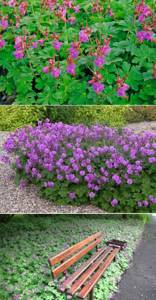
Horny goat weed (Epimedium)
Also known as Horny Goat Weed, Epimedium is ideal for covering the soil under the tree canopy. Easy to care for, frost-resistant large-flowered epimedium (Epimedium grandiflorum). This species produces decorative leaves and attractive flowers that resemble exotic insects. An interesting variety is "Purple Pixie" with semi-evergreen leaves and purple-violet flowers. Grows up to 30 cm. The leaves are green with thin spines along the edges. Young leaves are brown.
Epimedium grows best in semi-shady or shady locations in fertile, moderately moist, well-drained soils. Old plants tolerate lack of water well. They are best planted in large groups under the canopy of trees and shrubs.
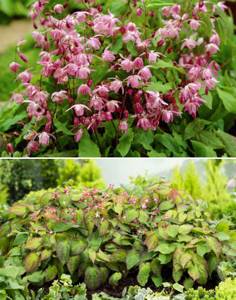
Dogwood (dogwood) Canadian
The dwarf Canadian derain shrub (Cornus canadensis), 10-20 cm high, is a typical lawn plant. Forms dense, green carpets. During the season it is decorated with large, green leaves. The leaves fall off in late autumn, but may remain on the plant in mild winters. Canadian derain is most decorative in the spring (April-May), when it blooms. When the turf fades, the flowers turn into decorative, round, bright red, edible fruits.
Despite its small size, the Canadian dogwood is quite demanding. Its natural habitat is forests; it grows best in semi-shaded areas, under trees. The preferred soil is humus, permeable, fertile, constantly slightly moist, with an acidic pH. Despite the shallow root system, Canadian dena tolerates drought and heat. During drought, irrigation is required. It does not tolerate heavy, cold, wet soil, in which it grows very poorly. Quite frost-resistant.
Canadian dogwood is a wonderful trailing plant for shaded areas. It is demanding and capricious, but in the right places it will grow beautifully, creating thick green carpets.
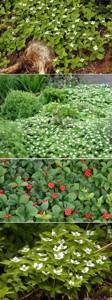
Creeping tenacious
The creeping insect (Ajuga reptans) loves semi-shaded and shaded places. Height depending on the variety: 10-20 cm. Small dark blue flowers are collected in a cluster at the top of the stem. There are garden varieties with white or pink flowers. Flowering date: May-August.
The year-round decoration of the plant is evergreen leaves. The brown-purple leaves of the Atropurpurea variety are especially decorative. Creeping tenacious creates compact bushes that combine well with other plants.
The plant is very easy to grow, it is frost-resistant; in snowless winters the leaves can freeze. Loves damp areas. Soil: humus and moist with a neutral reaction. Loves partial shade, can grow in full sun in moist soil. Planted under bushes, in the shade of trees, suitable for lining slopes, preventing landslides. Suitable for planting near bodies of water (loves moisture).
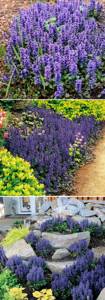
Cotoneaster horizontal
The horizontal cotoneaster shrub (Cotoneaster horizontalis) reaches 50 cm - 1 meter in height and 1.5 meters in width. The shoots grow almost horizontally and branch. The bush forms several main rigid branches, from which flat, brown shoots regularly emerge. The leaves are small, dark green, shiny, oval. In autumn the leaves turn red and orange.
Horizontal irga blooms in May - June. The flowers are small, numerous, white or white-pink. In September-October, small orange-red shiny fruits appear and remain on the branches all winter. Irga horizontalis is a honey plant.
The shrub is not demanding. Loves sandy or clay soil, with an average humus content, moderately moist. Grows in sunny and semi-shaded places. It is poorly affected by heavy, wet soils and prolonged drought. Frost-resistant, tolerates winter well under snow cover, but can freeze without snow. The shrub does not require pruning and grows quickly. Resistant to pests and diseases.
Irga is recommended for rockeries, flower beds, landscaping walls, slopes. Ideal as a ground cover shrub - it covers unattractive areas in the garden very well.

Bluebell Carpathian
The mountain perennial Carpathian bellflower (Campanula carpatica) is valued for its numerous bell-shaped flowers and low habitat requirements. Blooms in the second year of cultivation. Especially suitable for flower beds and rock gardens. Requires humus-clay soil, sunny or semi-shaded place.
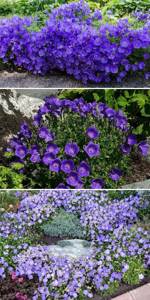
European hoofweed
The creeping, low-growing perennial European hooffoot (Asarum europaeum) is suitable for shaded positions - under trees and shrubs. Glossy leaves with a characteristic shape are very decorative. The rhizome of the hoofweed is located close to the ground, so it should be planted shallow. The flowers are brown and inconspicuous.
The hoof grows slowly. Does not tolerate drought well and may require watering. On fertile soil it forms a dense, bright, green carpet. The planting rate is 16 pieces per 1 m².
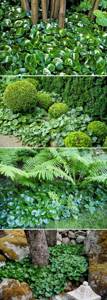
Indian cinquefoil
A herbaceous plant reminiscent of strawberries - Indian cinquefoil (Duchesnea indica) - a low (10 cm), attractive perennial. The versatile plant produces edible fruit and is easy to grow.
The flowers are inconspicuous, yellow, appearing from mid-spring until the first autumn frosts - the plant is simultaneously strewn with flowers and bright red fruits. The leaves resemble strawberry leaves. The fruits are bright red, edible, but tasteless. The species grows easily and quickly, and can suppress other plants.
Recommended for large lawns and rock gardens. A winter-hardy plant, but in cold regions of the country it requires shelter for the winter. Grows best in a sunny or slightly shaded location, in permeable, fertile soil. Planted at a distance of 30 × 30 cm.
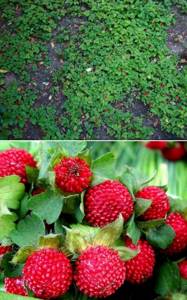
Myhenia nettlefolia
The rare garden plant Meehania urticifolia produces very long shoots. Winters well in our climate. Bright green leaves. Azure-blue flowers with a pale center look very exotic and have an intriguing scent. Flowering begins at the end of April, blooms profusely in May.
The best position is semi-shady and shady. Any garden soil will do, preferably moist, maybe loamy.
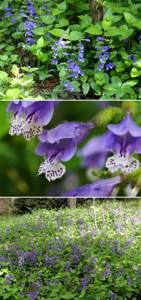
Juniper
When landscaping large areas in a sunny place, creeping junipers are best suited. They are durable, undemanding, and look attractive all year round. Below are some recommended groundcover varieties of junipers up to 20 cm high:
- "Green Carpet" - slow growing, green needles;
- “Blue Chip” – silver-blue needles;
- “Golden Carpet” – golden yellow color of needles;
- "Wiltonii" - blue-green shoots, strong growth;
- "Nana" - slow growing, green needles.

Bryozoan awl-shaped
The bryozoan plant (Sagina subulata) grows up to 2-5 cm in height, forming a low, dark green lawn cushion consisting of long creeping shoots with even leaves. Blooms from April to July. The flowers are small, white, numerous, fragrant, grow on long stems, and have five petals with a yellow center.
Bryozoan awl-shaped grows in average soil, sandy, slightly moist. Requires a sunny or semi-shady position. Used for planting rock gardens instead of lawns. It looks beautiful surrounded by stones and perfectly fills the space between paving slabs.

Aubrieta cultural
A low decorative perennial, Aubrieta × cultorum, 5-10 cm high, creates dense, compact bushes. The stems are highly branched. The leaves are very small, matte, pubescent, gray-green, oval-shaped, strongly toothed. Small flowers of aubrieta are collected in short clusters and smell pleasant. It blooms for a long time: from April to June. The color of the flowers, depending on the variety, can be pink, purple, blue, red, white.
Obrieta needs a warm, sunny place, alkaline or neutral, moderately moist soil. Does not like wet soils or dry places. The plant is frost-resistant, evergreen. The perennial is ideal for rockeries, borders, and flower beds.

White sedum
White sedum or sedum (Sedum album) is a popular perennial planted on rocks, slopes, walls, as a lawn plant. Forms loose bushes, grows 7-10 centimeters in height. Small, white, star-shaped flowers appear in June. The flowers remain on the plants until August, creating picturesque white cushions. The leaves are fleshy, cylindrical, densely arranged on creeping shoots, dark green, turning slightly red in autumn. The leaves remain on the shoots for the winter. The plant tolerates frost well and overwinters under snow cover.
White sedum grows well in any garden soil, except heavy loamy, excessively wet soil. Dry, sandy, limestone soil is better suited. The position should be sunny.
Popular varieties of white sedum:
- “Coral Carpet” – in autumn the leaves acquire an intense red color;
- "Chloroticum" - small, spherical, light green leaves;
- "Murale" - red-brown leaves, pinkish flowers.
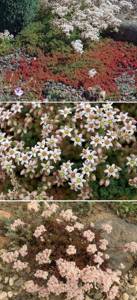
Caustic sedum
This evergreen perennial is found in the wild in Africa, Asia, and Europe. Grows on rocks, dry slopes, sandy hills, meadows. Frost-resistant, very undemanding - rather poor sandy and permeable soils. Tolerates lack of water well (stores moisture in small leaves). Should grow in full sun.
This is one of the lowest sedum plants grown for decoration. During flowering it is covered with a mass of yellow flowers. Excellent look for lawns and rock gardens.
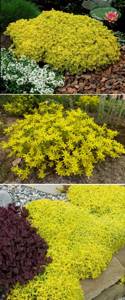
Pachysandra japonica
An evergreen shrub from the boxwood family, Japanese pachysandra (Pachysandra) loves shaded positions. The shiny, all-season leaves, 10 cm long, are arranged in rosettes at the ends of the shoots. Small, inconspicuous flowers appear in May. The variety "Variegata" is characterized by light leaves. Japanese pachysandra grows quickly, creating carpets that can replace lawns.

Grows well under tall trees. To achieve rapid compaction of plants, they should be planted at a distance of 20-25 cm.
Requires frequent watering, semi-sunny or shady positions, moist, humus soils. Tolerates air pollution well.
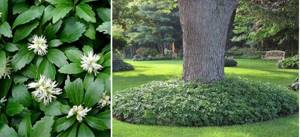
Ivy
Ivy (Hedera helix) covers the walls of buildings and the soil under trees. An evergreen and expansive climbing shrub, about 20 meters high. It climbs onto supports using aerial roots. Characterized by relatively fast growth (up to 1 meter per year), original foliage. The leaves are leathery, shiny, dark green, winter-hardy, turning red in winter.
Flowers appear on older specimens and are small and cream-colored. They bloom from September to October and emit a pleasant honey-like aroma. The fruits are spherical, blue-black when ripe, ripen in April-May.
Looks great next to walls, on old tree trunks. Loves semi-shady, shady areas. Prefers moderately fertile, slightly moist soil. Frost-resistant. All parts of the plant are poisonous due to the presence of saponins.

Rezuha Caucasian
A perennial native to the Mediterranean and Caucasus region, Caucasian rhizome (Arabis caucasica) 10-20 cm high creates soft cushions. Branched, densely leafy shoots and grayish-green climbing leaves remain on the plant in winter. Rezuha is frost-resistant.
Rezuhi begin to bloom in early spring - from March to April. The flowers are snow-white, honey-bearing, collected in clusters. The perennial requires soil that is not very fertile and permeable. It can be planted along the edges of flower beds, in wall crevices, and rock gardens. Perfectly covers flower beds.
Varieties:
- “Plena” – with double flowers, blooms a little later but much longer;
- 'Variegata' has green greyish leaves with creamy white serrated edges and grows a little slower.
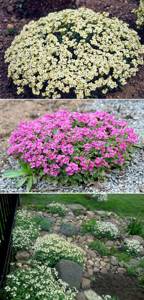
Common borer
A perennial with decorative green leaves with a white edge, the common gooseberry (Aegopodium podagraria) grows vigorously. The stem is vertical, branching from above, the height varies between 50-100 cm. Underground, creeping, strong rhizomes allow the plant to spread quickly. The leaves are long-petiolate, smooth. Small flowers form large inflorescences. The petals are white or light pink, with tips curved inward. Blooms from June to July.
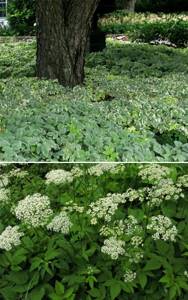
Loves deciduous forests, gardens, roadsides, pond banks, and often grows near fences. In agriculture, this is a persistent weed; it has enormous competitive power in relation to other species, thanks to which it quickly takes over the area. Often takes up entire fields. Loves soils rich in humus and nitrogen. Loves shady places. Can be grown under trees as a ground cover. It should not be planted next to other ornamental plants; it can easily “smother” them.
Photo. Dry variety "Variegata" with white leaf edges
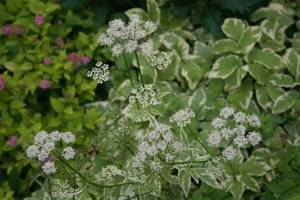
creeping thyme
An extremely valuable perennial for its healing and decorative properties is creeping thyme (Thymus serpyllum). Thyme smells great and is relatively resistant to trampling. It blooms from June to August, forming inflorescences with lilac-pink flowers. Its pinkish flowers stand out perfectly against the background of small elliptical leaves. Height varies from 5 to 30 cm. The shoots are creeping. Frost-resistant.
Thyme has many uses: ideal for rockeries, beds, slopes, borders, herbaceous corners.

Fragrant violet
The low perennial fragrant violet (shoot height is 5-10 cm) creates underground rhizomes. Violet has intensely fragrant purple or white flowers that were used to make perfume. It blooms in April–May and repeats flowering in the fall. The leaves are green, shiny, heart-shaped at the base.
Violet is ideal for flower beds, border beds, and rock gardens. It is an edible plant with a subtle, sweet taste. Fresh flowers can be added to vegetable and fruit salads. A soothing tea can be made from flowers and leaves. Violet is easy to grow and has no special requirements. Loves shaded positions and grows in any soil.
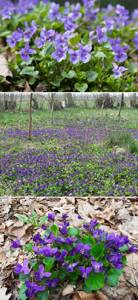
Phlox Covilla
Ground cover creeping flowers - Coville phlox, also called snow phlox (Phlox covillei), form dense carpets. Usually grows to a height of 2-3 cm. The leaves are small, dark green, lanceolate. The flowers are white and appear in April.
Phlox Coville has the same requirements as other representatives of the species - it prefers sunny places (where it blooms more abundantly), and can grow in partial shade. Permeable, sandy soils are optimal. It is not completely frost-resistant, it is recommended to cover it before the onset of winter. Can be used to decorate rock gardens, planted along the edges of paths, walls, flower beds.

Phlox subulate
The unique perennial carpet plant Phlox subulata produces beautiful carpets of numerous flowers that bloom from April to June. Phlox is easy to grow. The plant loves the sun and does not require frequent watering. Together with other varieties of phlox, it can create a wonderful color palette to cover empty spaces in a flower bed.
An ideal perennial for rocky gardens, suitable for lining slopes and walls, thanks to its strong root system that binds the soil. Can withstand frost and drought.

Chistets Byzantine
The ground cover creeping perennial Stachys byzantina forms dense clusters of bushes. Grows up to 40 cm, creates decorative silver carpets.
The leaves are large, ovate, covered with dense, soft, silvery pubescence, and remain on the plant in winter. Blooms from June to August. The inflorescences are decorative at the initial stage. Chistet is not demanding, tolerates drought well, can grow in sunny and semi-shaded places (the leaves are more silvery in sunny places). The soil is sandy loam, permeable, not too wet. Tolerant to substrate pH. Completely frost-resistant.
In gardens it is used for planting in flower beds, borders, rock gardens, and as a ground cover. Can be planted in small groups or over large areas (the number of plants per 1 m² is 12 pieces).
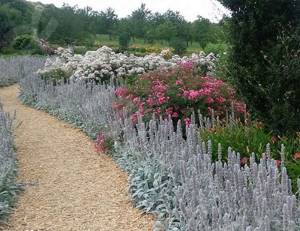
Speckled lily
The native plant, Lamium maculatum, is commonly found in bushes, ditches, and pastures. Perennial with decorative leaves, shoot height – 20 cm. Rough serrated, silvery leaves with a narrow green edge. Purple flowers grow vertically in the axils of the leaves.

Laminaria requires humus soil, not too dry. Hates strong sun. Recommended as lawn grass or for planting in small groups of 3-10 pieces. Number of plants per 1 m² – 12.
Varieties:
- "Beacon Silver" - silver leaves with a green border;
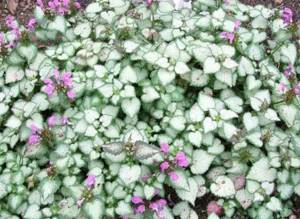
- "Golden Anniversary" - green leaves with golden edges, blooms white.
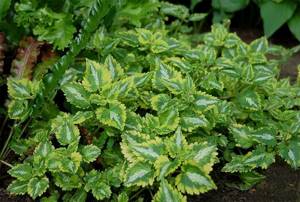
Felt cleaver
An undemanding, fast-growing perennial - tomentosum (Cerastium tomentosum). The main growing condition is exposure to full sun. Jaskolka grows wild in the mountains of the Apennine Peninsula. The gray-silver stems and leaves are covered with fine hairs, giving them a mossy appearance. The moth grows quickly, creating large cushions of creeping shoots. During flowering it is covered with small white flowers. This is an excellent ground cover, hardy, drought-tolerant plant.
The plant has no special requirements: it grows on moderately fertile garden soils and tolerates drought. Suitable for rock gardens, walls, slopes, borders. The plant will create a spectacular backdrop for conifers and bulbous plants.
